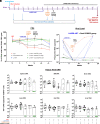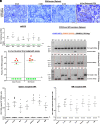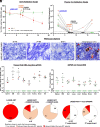CRISPR editing of CCR5 and HIV-1 facilitates viral elimination in antiretroviral drug-suppressed virus-infected humanized mice
- PMID: 37126704
- PMCID: PMC10175831
- DOI: 10.1073/pnas.2217887120
CRISPR editing of CCR5 and HIV-1 facilitates viral elimination in antiretroviral drug-suppressed virus-infected humanized mice
Abstract
Treatment of HIV-1ADA-infected CD34+ NSG-humanized mice with long-acting ester prodrugs of cabotegravir, lamivudine, and abacavir in combination with native rilpivirine was followed by dual CRISPR-Cas9 C-C chemokine receptor type five (CCR5) and HIV-1 proviral DNA gene editing. This led to sequential viral suppression, restoration of absolute human CD4+ T cell numbers, then elimination of replication-competent virus in 58% of infected mice. Dual CRISPR therapies enabled the excision of integrated proviral DNA in infected human cells contained within live infected animals. Highly sensitive nucleic acid nested and droplet digital PCR, RNAscope, and viral outgrowth assays affirmed viral elimination. HIV-1 was not detected in the blood, spleen, lung, kidney, liver, gut, bone marrow, and brain of virus-free animals. Progeny virus from adoptively transferred and CRISPR-treated virus-free mice was neither detected nor recovered. Residual HIV-1 DNA fragments were easily seen in untreated and viral-rebounded animals. No evidence of off-target toxicities was recorded in any of the treated animals. Importantly, the dual CRISPR therapy demonstrated statistically significant improvements in HIV-1 cure percentages compared to single treatments. Taken together, these observations underscore a pivotal role of combinatorial CRISPR gene editing in achieving the elimination of HIV-1 infection.
Keywords: CCR5 targeting; CRISPR-Cas9; HIV-1; humanized mice; long-acting ART.
Conflict of interest statement
K.K. is a named inventor on patents that cover the viral gene-editing technology for Excision BioTherapeutics. T.H.B. holds equity in Excision BioTherapeutics. B.E. and H.E.G. are co-founders of Exavir Therapeutics, Inc. and hold patents on the long-acting slow effective release antiretroviral therapies tested in this manuscript. The authors have the following patent filings to disclose: Prodrugs and Formulations Thereof, Publication number: 20220288037; Abstract: The present invention provides prodrugs and methods of use thereof. Type: Application Filed: August 21, 2020; Publication date: September 15, 2022; Inventors: B.E. and H.E.G., Antiviral Prodrugs and Nanoformulations Thereof, Publication number: 20220211716; Abstract: The present invention provides prodrugs and methods of use thereof. Type: Application Filed: March 18, 2022; Publication date: July 7, 2022; Inventors: H.E.G. and B.E., Antiviral Prodrugs and Nanoformulations Thereof, Publication number: 20220175936; Abstract: The present invention provides prodrugs and methods of use thereof. Type: Application Filed: November 27, 2019, Publication date: June 9, 2022; Inventors: H.E.G. and B.E., Methods and Compositions for RNA-Guided Treatment of HIV Infection. Publication number: 20220313795; Abstract: A method of preventing transmission of a retrovirus from a mother to her offspring, by administering to the mother a therapeutically effective amount of a composition comprising a CRISPR-associated endonuclease, and the two or more different multiplex gRNAs, wherein each of the at least two gRNAs is complementary to a different target nucleic acid sequence in a long terminal repeat (LTR) of proviral DNA of the virus that is unique from the genome of the host cell, cleaving a double strand of the proviral DNA at a first target protospacer sequence with the CRISPR-associated endonuclease, cleaving a double strand of the proviral DNA at a second target protospacer sequence with the CRISPR-associated endonuclease, excising an entire HIV-1 proviral genome, eradicating the HIV-1 proviral DNA from the host cell, and preventing transmission of the proviral DNA to the offspring. Type: Application Filed: May 24, 2021; Publication date: October 6, 2022; Inventors: K.K. and Wenhui Hu.
Figures




References
-
- Hutter G., et al. , Long-term control of HIV by CCR5 Delta32/Delta32 stem-cell transplantation. N. Engl. J. Med. 360, 692–698 (2009). - PubMed
-
- Hsu JingMei B. K. V., et al. , HIV-1 Remission with CCR5delta32delta 32 Haplo-cord Transplant in a U. S. Woman: IMPAACT P1107. in CROI 26 (2022).
-
- Huang Y., et al. , The role of a mutant CCR5 allele in HIV-1 transmission and disease progression. Nat. Med. 2, 1240–1243 (1996). - PubMed
Publication types
MeSH terms
Substances
Grants and funding
- T32 MH079785/MH/NIMH NIH HHS/United States
- R01 MH115860/MH/NIMH NIH HHS/United States
- R01 AI145542/AI/NIAID NIH HHS/United States
- R01 DA054535/DA/NIDA NIH HHS/United States
- R01 AI158160/AI/NIAID NIH HHS/United States
- R01 MH121402/MH/NIMH NIH HHS/United States
- P30 MH092177/MH/NIMH NIH HHS/United States
- R01 NS126089/NS/NINDS NIH HHS/United States
- R01 NS034239/NS/NINDS NIH HHS/United States
- R21 MH131220/MH/NIMH NIH HHS/United States
- R01 NS036126/NS/NINDS NIH HHS/United States
- R33 DA041018/DA/NIDA NIH HHS/United States
- UM1 AI164568/AI/NIAID NIH HHS/United States
- T32 NS105594/NS/NINDS NIH HHS/United States
LinkOut - more resources
Full Text Sources
Medical
Research Materials

